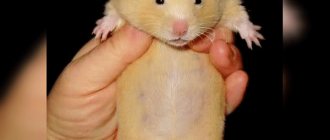Sexual maturity in rodents
Maturation occurs at different ages. Males reach sexual maturity after six months, but it is recommended to allow them to breed no earlier than 10-12 months.
Females are ready to reproduce at 3-4 months. If the animals are not looked after, then pregnancy may occur already at this age. However, such early offspring does not always have a beneficial effect on health.
The age for the first mating of females occurs at 6-8 months.
Individuals that, although they have reached sexual maturity, weigh less than 500 grams should not be allowed to reproduce. The period of estrus and readiness for fertilization can be determined by the behavior of the male. If the animals live in the same cage, then the partner begins to tenderly care for the partner. If the animals live separately, the male makes peculiar sounds and makes characteristic movements with his tail.
Rules for keeping chinchillas.
General recommendations
Sexual maturity in females occurs at approximately 6-7 months, in males somewhat later - at approximately 9 months. Some chinchillas come into heat quite early, at 3-4 months, but it is recommended to mate the animals only after reaching a year. By this moment, the female has reached the size necessary for normal bearing of offspring. Early birth can cause physical damage to the health of a chinchilla and make it aggressive towards the male and cubs.
It should be taken into account that in order to give birth to healthy and strong offspring, both the male and the female must be healthy and strong. Mating of exhausted or weak animals is fraught with the death of the chinchilla during childbirth or the production of sick and non-viable puppies.
To reproduce, rodents need to form a pair. A healthy female, 12 months of age or older and weighing at least 0.5 kg, must be placed in a cage with a male. It is recommended to select a male who is 2-5 months older. At the same time, chinchillas can exist both in monogamous pairs, which consist of one female and a male, and in polygamous groups formed by a male and several females. In the second case, each animal must live in its own enclosure.
The female and male can live together or separately. If you plan to place rodents only for the mating period, you should choose the most appropriate moment. The chinchilla's reproductive cycle lasts approximately 28-29 days. At the same time, estrus continues for about 3-4 days, during which the female secretes a special secretion.
A few days before this period, the animals should be placed in one enclosure. When rodents are ready to breed, their behavior changes: the male becomes playful and chases the female around the cage, making cooing sounds. At the same time, the female behaves restlessly, moves a lot, scatters food and sand around the enclosure. A characteristic sign of readiness for mating is the enlargement and hyperemia of the chinchilla’s genitals.
After placing the rodents, it is recommended to keep a diary or calendar in which you need to note the periods of estrus in the female and the expected dates of mating of the animals. This will allow you to estimate the approximate date of birth of the offspring and prepare in advance for childbirth.
Prices for a chinchilla cage
How long does pregnancy last?
Pregnancy in chinchillas, by the standards of representatives of the Rodent order, is quite long, and beginners in breeding need to know that:
- newborn puppies appear 105-110 days after mating;
- a pregnant female gains weight;
- Usually an active animal, when pregnancy occurs it becomes less active.
The birth date can be calculated if the owner of the rodent noticed the process of mating the animals.
How to tell if a chinchilla is pregnant
In the early stages, pregnancy in these big-eyed animals is practically invisible. Mating occurs at night, and a young primiparous individual may not have a plug at all. For successful mating, partners need to be seated correctly so that there is no mutual aggression and hostility among the animals. A reliable sign that a female has become pregnant is that she has not gone into heat for a month.
ATTENTION! Despite early puberty, it is not recommended to board animals under 12 months of age.
Early pregnancy leads to:
- Stopping the development of the female;
- pathologies of embryo development;
- severe pregnancy;
- miscarriages;
- death of cubs at an early age;
- general weakening and health problems in the female.
Characteristic signs of pregnancy in a chinchilla
From the 8th week of a pregnant chinchilla, even a novice breeder will be able to determine the presence of pregnancy. To begin with, you should pay attention to the animal’s nipples. In a non-pregnant animal, they do not stand out and are not felt when stroking the fur. And already from the fifth week of pregnancy, the nipples of a pregnant female begin to swell, turn red and stand out. In the last weeks before giving birth, white colostrum may be released from the nipples.
REFERENCE: Pregnancy is the period of pregnancy in chinchillas.
Pregnant females have an increased appetite
Increased rodent appetite
A pregnant female chinchilla, like any other animal, has an increased appetite. She drinks and eats much more often, as developing puppies need nutrition, proteins and microelements. This is also one of the signs that the animal is pregnant.
Changing the appearance of the nipples
During pregnancy, the female's nipples stand out from the fur, change their color and become more sensitive. As a rule, lactation occurs from only one pair of nipples. The whitish discharge in recent weeks is called colostrum and is not dangerous.
Animal weight gain
Naturally, if there are embryos, the weight of the chinchilla will increase. The weekly increase can reach up to 15 grams. It is recommended to carry out control weighings every week to monitor the progress of pregnancy and record the scale readings on paper or electronically. It is not recommended to take the animal by the tail for weighing. This can cause premature birth or miscarriage. At a later stage, weighing is no longer performed so as not to expose the female to additional stress.
Increased urination
A pregnant animal performs many more acts of urination compared to the pre-pregnant period. This is due to the fact that the enlargement of the uterus leads to compression of the bladder and an increase in the number of urges.
After 90 days of pregnancy, you can feel the babies in your stomach
Abdominal enlargement
The rounding and enlargement of the tummy is clearly evident from the 8th week of pregnancy of the chinchilla. With the further development of pregnancy, fetal movements can be observed with the naked eye. After 90 days, you can already feel the cubs in the mother’s belly with your hand. But in order not to provoke a miscarriage, it is not advisable for owners of furry animals to do this.
Changes in the behavior of a pregnant female
Pregnant chinchillas become less and less active as pregnancy progresses. At the same time, they will be noticeably calmer and more affectionate towards their owner. The animal sleeps more often on its side; in later stages, you can observe the female sitting on her back. Before the onset of childbirth, the female becomes restless, frightened by sharp sounds and shows aggression towards the male.
Ultrasound diagnostics and radiography
Ultrasound diagnostics when an animal becomes pregnant is needed to confirm this fact and exclude obvious pathologies. X-rays are carried out in the later stages of pregnancy to determine the number of cubs, when their skeletons are already ossified. Also at this time they look at the presentation of the fetuses. If you have any questions or concerns, you should immediately contact your veterinarian. You should not give your animal medications on your own without a prescription.
Loop change
Before giving birth, the female's external genitalia become red and increase in size. The male may perceive this as estrus and try to mate with a pregnant chinchilla. And sexual intercourse during pregnancy can cause a miscarriage or other problems during pregnancy. Therefore, it is recommended to place the male in a separate cage for several months a couple of weeks before the expected date of birth.
If the owner notices purulent discharge from the loop, a change in the behavior or appetite, as well as the activity of the pregnant chinchilla, then you should immediately take the animal to a qualified veterinarian, who will determine the possibility of maintaining the animal’s pregnancy or perform an emergency cesarean section. In this case, the question of the life of the cubs no longer arises; the mother is saved.
It is better to disturb a pregnant woman as little as possible
Signs
Early symptoms
How to determine if chinchillas are pregnant? In the first weeks, determining the onset of conception is problematic. If the owner already has experience, he may notice:
- changes in behavior, drowsiness;
- at about 7-8 weeks, the appearance of the female’s nipples changes: in a non-pregnant woman they are white, and in a pregnant woman at the end of the second month they become pink and swollen;
- the animal begins to gain weight well after 8 weeks.
In some females, you may notice a white, paraffin-like plug coming off. As soon as the first such plug was discovered at the bottom of the cage, the countdown can begin. Most likely, the appearance of offspring will occur on the 105th day after this event.
To accurately determine the date of birth, it is advisable to keep a special diary. It records the mating date and all changes that occur to the animal.
Walking ball for chinchillas.
Chinchilla birth chart
To make it easy to determine the date of birth, there is a simple table of average pregnancy periods. The error in the table is due to the fact that signs of pregnancy are not immediately noticeable, and ranges from one to four days.
The top lines correspond to the mating date (taking into account the error), the bottom lines correspond to the day of birth. For example, if conception occurred on January 6, the chinchillas will be born presumably on April 26. For ease of reference, the required date is highlighted in black or red.
Table of pregnancy and birth in chinchillas:
| January April | 1 2 3 4 5 6 7 8 9 10 11 12 13 14 15 16 17 18 19 20 21 22 23 24 25 26 27 28 29 30 31 21 22 23 24 25 26 27 28 29 30 1 2 3 4 5 6 7 8 9 10 11 12 13 14 15 16 17 8 19 20 21 |
| February May | 1 2 3 4 5 6 7 8 9 10 11 12 13 14 15 16 17 18 19 20 21 22 23 24 25 26 27 28 22 23 24 25 26 27 28 29 30 31 1 2 3 4 5 6 7 8 10 11 12 13 14 15 16 17 18 |
| March June | 1 2 3 4 5 6 7 8 9 10 11 12 13 14 15 16 17 18 19 20 21 22 23 24 25 26 27 28 29 30 31 19 20 21 22 23 24 25 26 27 28 29 30 1 2 3 4 5 6 7 8 9 10 11 12 13 14 15 16 17 18 19 |
| April July | 1 2 3 4 5 6 7 8 9 10 11 12 13 14 15 16 17 18 19 20 21 22 23 24 25 26 27 28 29 30 20 21 22 23 24 25 26 27 28 29 30 31 1 2 3 4 5 6 7 8 9 10 11 12 13 14 15 16 17 18 |
| May August | 1 2 3 4 5 6 7 8 9 10 11 12 13 14 15 16 17 18 19 20 21 22 23 24 25 26 27 28 29 30 31 19 20 21 22 23 24 25 26 27 28 29 30 31 1 2 3 4 5 6 7 8 9 10 11 12 13 14 15 16 17 18 |
| June September | 1 2 3 4 5 6 7 8 9 10 11 12 13 14 15 16 17 18 19 20 21 22 23 24 25 26 27 28 29 30 19 20 21 22 23 24 25 26 27 28 29 30 1 2 3 4 5 6 7 8 9 10 11 12 13 14 15 16 17 18 |
| July October | 1 2 3 4 5 6 7 8 9 10 11 12 13 14 15 16 17 18 19 20 21 22 23 24 25 26 27 28 29 30 31 19 20 21 22 23 24 25 26 27 28 29 30 31 1 2 3 4 5 6 7 8 9 10 11 12 13 14 15 16 17 18 |
| August November | 1 2 3 4 5 6 7 8 9 10 11 12 13 14 15 16 17 18 19 20 21 22 23 24 25 26 27 28 29 30 31 19 20 21 22 23 24 25 26 27 28 29 30 1 2 3 4 5 6 7 8 9 10 11 12 13 14 15 16 17 18 19 |
| September December | 1 2 3 4 5 6 7 8 9 10 11 12 13 14 15 16 17 18 19 20 21 22 23 24 25 26 27 28 29 30 20 21 22 23 24 25 26 27 28 29 30 31 1 2 3 4 5 6 7 8 9 10 11 12 13 14 15 16 17 18 |
| October January | 1 2 3 4 5 6 7 8 9 10 11 12 13 14 15 16 17 18 19 20 21 22 23 24 25 26 27 28 29 30 31 19 20 21 22 23 24 25 26 27 28 29 30 31 1 2 3 4 5 6 7 8 9 10 11 12 13 14 15 16 17 18 |
| November February | 1 2 3 4 5 6 7 8 9 10 11 12 13 14 15 16 17 18 19 20 21 22 23 24 25 26 27 28 29 30 19 20 21 22 23 24 25 26 27 28 1 2 3 4 5 6 7 8 9 10 11 12 13 14 15 16 17 18 19 20 |
| December March | 1 2 3 4 5 6 7 8 9 10 11 12 13 14 15 16 17 18 19 20 21 22 23 24 25 26 27 28 29 30 31 21 22 23 24 25 26 27 28 29 30 31 1 2 3 4 5 6 7 8 9 10 11 12 13 14 15 16 17 18 19 20 |
Determining an “interesting situation” at a later stage
In the first months, the female's weight changes very slowly. She gains no more than 10 - 30 g per week. In the second half of the term, weekly gains can increase to 40 g or more. Uneven weight gain is the norm for these animals.
At the end of pregnancy the following happens:
- about 14 days before birth, you can feel with your hand and even see the movement of the babies in the stomach; if the puppy is alone, then these signs may not be noticed;
- just before birth, sometimes 5-7 days before, the opening of the loop is observed;
- a few days before giving birth, the animal builds a nest and digs for filler.
In later stages, puppies can be detected by feeling the animal.
However, this should not be done if you lack the skill.
Chinchilla behavior during pregnancy
The behavior of chinchillas during pregnancy directly depends on their temperament and health status. If the female is young, then pregnancy proceeds normally, behavior changes only on the eve of childbirth.
Sudden changes in behavior may indicate:
- Hormonal changes are a temporary phenomenon that does not last longer than 3-4 days.
- Stress or discomfort - in this case, irritation, depression, and chronic fatigue are observed. The female is constantly trying to build a shelter or hiding in the far corner of the cage.
From the experience of owners, the following common behavioral metamorphoses can be identified:
- The female begins not only to eat more, but also actively stores, even if she was not inclined to such behavior before.
- Friendly, sociable females can become territorial and even begin to mark.
- Independent females become more sociable and even intrusive.
Experts advise to be calm about changes in the behavior of pregnant chinchillas if you do not observe any alarming symptoms.
Try not to impose communication and attention on the expectant mother, but willingly respond to her initiative
During normal pregnancy, the female's weight increases gradually. Weight gain is due to the production of additional blood and fluid, the growth of embryos and the accumulation of a protective fatty layer in the mother in the peritoneal area.
The normal weight gain during pregnancy for a chinchilla is 25–30 grams. per month. In the last month, the range may be 30–50 grams. Normal, gradual weight gain is a sign of a normal pregnancy.
If the female is healthy at the time of fertilization, theoretically, pregnancy should proceed without complications. Temporary problems may arise if the female does not receive the required nutrition because the owner does not realize that his pet is pregnant. Other possible complications may be related to the quality of care and the environment:
Miscarriage. Most often it is provoked by problems with the cardiovascular system or the so-called blood conflict. Spontaneous miscarriage can occur at any stage of pregnancy. A special risk group includes females who do not receive adequate nutrition. Severe or prolonged stress can also be a factor that triggers a miscarriage. Injuries, fights, jumping, and falls can lead to spontaneous abortion. If the female has a miscarriage, she eats the premature embryos and placenta. Quite often, traces of blood (stains) are found in the cell.
Calcium deficiency. If there is a lack of calcium in the female, the quality of the coat and claws deteriorates, and problems with teeth may occur. The embryos suffer greatly. Puppies' bones and internal organs do not develop properly, which can lead to intrauterine death or the birth of offspring with physical defects.
Repeated pregnancy immediately after childbirth. Due to physiological characteristics, a female chinchilla can go into heat within 36 hours immediately after giving birth. Repeated pregnancy while nursing newborn offspring can lead to the death of the female and puppies.
Caring for a pregnant female
In the first few weeks, the female’s nutrition and care do not change; everything happens as usual.
As soon as the first signs of pregnancy become obvious, the daily diet is increased by 10 - 20%, and from the second half of the term - by 25%. Be sure to give expectant mothers rolled oats, good hay and green raspberry and nettle leaves.
Simultaneously with the general increase in the amount of feed, it is necessary to provide for an increase in protein food by 15 - 18%. The diet should also contain calcium. This problem can be solved with the help of special drugs, for example, calcemin.
The diet of pregnant rodents does not change. Food is also given once a day, at the same hours.
Pregnant females should be able to move freely. The period of sleep may become longer. The cage is kept in order in the same manner as before pregnancy, approximately once a week.
During this period, you should not make drastic changes to your usual interior.
Carrying for chinchillas.
Newborns
Chinchillas are born with open eyes and sharp teeth. Usually, to keep warm, they crawl under their mother until they are completely dry. In the first days, mother's milk is enough for them. Although the mother has 6 nipples, usually only two are active, in rare cases four. Therefore, be sure to make sure that food gets equally to all the kids, and not just the strongest.
If babies start fighting, most likely they are hungry and lack milk. You will have to bottle feed your babies. It is recommended to prepare the following mixture: 1 part of high-quality condensed milk without sugar is mixed with two parts of chamomile decoction and heated in a water bath to room temperature. It is advisable to give the solution from a special nipple or syringe without a needle.
Feed should be given slowly so that the baby does not choke, this can lead to food getting into the respiratory tract, which will lead to the development of pneumonia. Remember that chinchillas already have sharp teeth, so you can’t feed them from a glass pipette; your baby can easily crush the glass. In the first week, babies should be fed every 2 hours, in the second week - every 4 hours, then every 6 hours.
After just a week, you can add some crackers and granules to your diet, and after another week you can add hay to the menu. By the fifth week of life, babies can completely switch to solid food. Please note that if a chinchilla develops diarrhea during artificial feeding, you should stop feeding and switch only to chamomile infusion until the diarrhea stops completely!
To understand that everything is going well, you need to weigh your babies regularly. They must constantly gain weight.
Approximate weight standards for chinchillas:
- newborns - 30-60 grams;
- 2 weeks - 80-90 grams;
- monthly - 120-130 grams
.
At the age of 50-60 days, babies are separated from their mother.
Preparing the cell for birth
Some owners remove hanging elements from the cage, some leave everything as is, however, it is advisable to deprive the animal of the ability to rise from the floor to other levels. In any case, the cage of a giving birth chinchilla should have:
- drinking bowl;
- feeder;
- toilet tray.
Clean sawdust is poured onto the floor and/or clean diapers are placed.
The arrangement of the birthing house is of great importance:
- he should stand at the bottom of the cage;
- the design should allow you to monitor the puppies and restore order inside;
- the house must be “weighty” enough so that the animal cannot move it.
Many owners find houses without a bottom convenient.
The temperature in the room where the cage is located must be maintained at + 20 degrees.
How does the process work?
The movements of the female indicate that labor is approaching. If it begins to bend and stretch, this is a sign that there is no longer than one day left before the birth of the babies.
One of the main points of preparation for childbirth is the placement of the male. He is removed from the cage due to the fact that the female goes into heat immediately after giving birth and there is a high probability of mating. This is not beneficial either for the lactating female or for her offspring.
Chinchillas most often give birth in the early morning and can do without human help. The whole process takes from a few minutes to 5-6 hours. If the interval between the birth of puppies is significant, then the female can be supported with a small amount of sugar.
After the birth of the baby, the afterbirth is also born. It is eaten by the female.
Experienced breeders recommend keeping an ampoule with oxytocin on hand . Medicines are necessary if something goes wrong during childbirth, but without special knowledge these medicines are useless.
Possible complications and ways to resolve them
The female will need help if contractions continue and the puppy is not born . Sometimes walking or lightly massaging the abdomen with your fingers helps.
If the tail or paws have already been “born,” the female sometimes bites them off. In this case, the emerging parts of the body are carefully grasped and, by slightly “twisting,” they help the fetus move outward. Hours-long interruptions in childbirth are a common cause of death for chinchillas.
If the delay in birth is 10 - 12 hours, you should immediately take the animal to the doctor.
How babies are born
Chinchilla offspring are born weighing 30–60 g with open eyes and teeth and can almost immediately move independently over a short distance. Usually after some time they hide under their mother to dry out and warm up.
At first, babies eat mother's milk. Lactation begins one day after birth. Newborns feed on colostrum for 24 hours.
If for some reason they miss him, the owner will have to feed the kids. To do this, prepare a mixture of condensed milk without sugar and chamomile infusion in a 1:2 ratio. It is warmed to room temperature. Feeding is done with a syringe without a needle for the first 7 days every 2 hours, the second 7 - at an interval of 4 hours, the third week - at an interval of 6 hours.
At 2 months, small chinchillas will weigh about 80-90 g, at 12 months - 120-130 g. They are ready for independent life from 3 months.
So, if you are planning to breed chinchillas, then you need to prepare for this process, namely: create the required conditions (for example, purchase an additional cage for the male, who will need to be placed during pregnancy and the first time of feeding the babies); find a veterinarian who could provide assistance if necessary; decide whether you can provide the female with high-quality nutrition, care and observation during pregnancy, as well as provide artificial supplementary feeding to the babies, if necessary.
Proper handling of puppies
Unlike other rodents, chinchillas are born with open eyes, teeth and fur.
It’s not worth picking up a newborn just like that. They do this for weighing. The average puppy weight is 40 g.
At first, babies feed on colostrum and mother’s milk, and from the third to fourth week of life they become interested in the food of adult animals.
If more than two cubs are born, then you may have to feed the litter, since in a female, out of three pairs of mammary glands, only one “works”.
How to Handle Cubs
When the female leaves the nest after giving birth, the owner needs to remove the puppies with disinfected hands and remove the dead ones (if any). Hand washing is only allowed with laundry soap; perfumed soap will leave a smell on the cubs and scare away the female.
Babies left outside the nest need to be dried, warmed, given a drink from a pipette and placed with their mother.
After 24 hours, all newborns need to be weighed: the weight norm is from 30 to 70 g. The procedure is carried out every day at the same hour. Usually puppies gain one gram at a time. If it is less, additional feeding will help, or switching to artificial feeding (if the chinchilla has a small amount of milk).
Children are separated from their mother after 30 days, grouping heterosexual flocks. Young animals are fed with boiled and warm cow's milk for up to six months.
Feeding rules
If babies fight often, then this is a sure sign that they do not have enough mother's milk. You can feed them with “Kitty Milk” dry milk formula for kittens or “Agusha” cream for children. Newborns are fed with a syringe, and after 18 - 20 days the drinking bowl is filled with milk; at this age, puppies also eat adult food. Rolled oats are added to their diet.
Fully bottle-fed chinchillas often have digestive problems; for such cases, you need to keep espumizan or bobotik on hand.
The anticipation and birth of chinchilla babies is a responsible time for the owner of the animal. The process will go without complications if you follow the necessary recommendations. Sometimes it is enough to rely on nature and let the animal produce offspring on its own, but at the same time have the phone number of a veterinarian at hand.
What to feed a chinchilla after giving birth
When chinchilla labor ends with the appearance of babies, it’s time to think about the diet of the new mother.
The basis of nutrition will be calcium and protein. Fruits, nuts, rose hips, sprouted grains and herbs (alfalfa, vetch and nettle) are required.
You can’t do without dry (fat-free) milk, dairy products, meat and bone meal, calcium gluconate, berries and vitamin supplements.
The presence of liquid in the drinking bowl will help the individual cope with thirst. The bath is placed closer to the nest so that the female can easily reach it.











